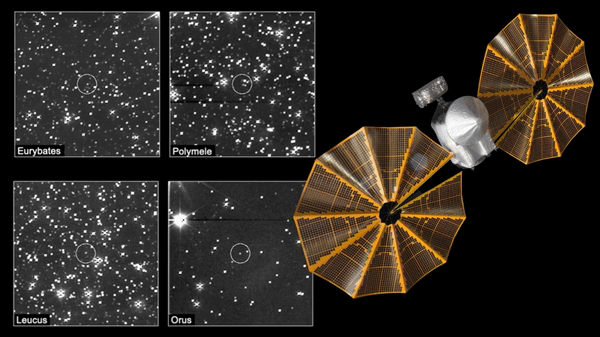NASA’s asteroid-hopping mission LUCY has captured the first images of its asteroid targets. The images of the asteroids, some of which are still 330 million miles (530 million kilometers) away from the spacecraft, were captured by LUCY between March 25 and March 27, 2023.
Despite being around three times the average distance between the sun and Earth from the asteroids, and the relatively small size of the space rocks, LUCY was able to catch four of its eight targets, Eurybates, Polymele, Leucus, and Orus. The images were taken with the spacecraft’s highest resolution imager, L’LORRI.
LUCY launched on Oct. 16, 2021 on a 12-year mission to become the first spacecraft to study the Jupiter Trojan asteroids, a group of space rocks gravitational bound to the largest planet of the solar system that are orbiting the sun together with the gas giant. The spacecraft will also become the first mission in history to visit so many different destinations in independent orbits around the sun.
Related: Meet the 10 asteroids NASA’s Lucy spacecraft will visit
LUCY will first make two passages of Earth performing gravity assist flybys that grant it energy and put it on a trajectory to reach six Trojan asteroids between 2027 and 2028, including the 42-mile-wide (68 km) space rock Eurybates and its satellite Queta, 17-mile-wide (27 km) Polymele and its yet-unnamed moon, 25-mile-wide (40 km) Leucus, and the 33-mile-wide (53 km) Orus.
After this, LUCY will return to Earth in around 2030 for a third gravity boost before heading off to the pair of giant asteroids known as Patroclus-Menoetius, which are each more than 60 miles (100 km) wide. LUCY will reach this double rock at around 2033.
There are over 7,000 Trojan asteroids in two swarms, one leading in front of Jupiter and the other trailing the gas giant. Between 1,800 and 2,000 of these bodies are estimated to have diameters in excess of 10 miles (15 km), which is more than the infamous Chicxulub asteroid that caused the extinction of dinosaurs 65 million years ago. Fortunately, these rocks have been firmly gravitationally bound to Jupiter for billions of years, so are unlikely to veer off and intersect with Earth’s orbit.
Asteroids like the Trojan swarm are composed of material that was left over from the formation of the sun and its planets, including Earth, around 4.6 billion years ago. This means studying asteroids can reveal details of how the solar system and its worlds have evolved.
With this in mind, the mission takes its name from the fossilized human ancestor named “Lucy,” which was discovered in 1974. The skeleton of Lucy provided unique insights into humanity’s evolution, akin to what scientists hope the spacecraft LUCY will do for the solar system.
The images captured by LUCY show the asteroids at the same scale but with variations in their orientation. This reflects how L’LORRI had to re-angle itself to glimpse each asteroid.
The time period of the observations also varied based on the asteroids’ individual rotational periods. LUCY watched the 32-mile (51 kilometers) wide Orus for the longest, taking images for 10 hours. The spacecraft observed Eurybates for a period of six and a half hours. Polymele and its 3-mile-wide (5 km) wide moon were observed for two and a half hours. LUCY observed the 13-mile (21-kilometer) wide asteroid moon Leucus for just two hours.
This won’t be the last time LUCY beams back images of the Trojan asteroids. Further investigations will measure how these objects reflect light at high angles that can’t be seen from Earth.
Currently, the asteroids LUCY will study appear as mere single specks of light against a background of distant stars, but the data the craft currently collects will help its operating team choose the exposure times LUCY uses during its close-up observations from 2027 onwards.
Follow us on Twitter @Spacedotcom or on Facebook.

